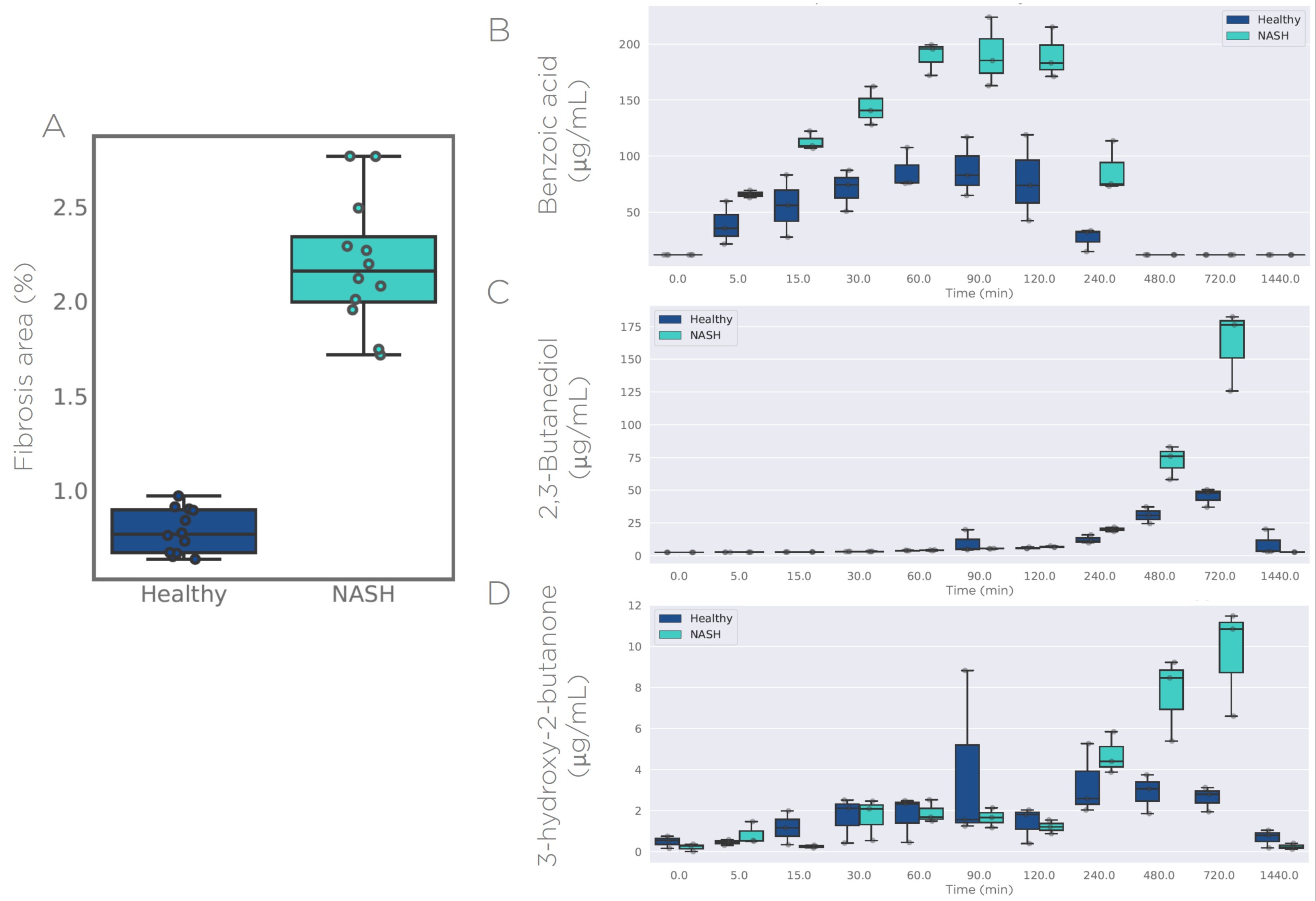Tuesday Poster Session
Category: Liver
P3816 - POSTER WITHDRAWN
Tuesday, October 24, 2023
10:30 AM - 4:00 PM PT
Location: Exhibit Hall

Has Audio
Award: Presidential Poster Award
Giuseppe Ferrandino, , Federico Ricciardi, , Antonio Murgia, , Max Allsworth, , Billy Boyle, , Karina B. Joyce, MSc, Olga Gandelman, MBA
Owlstone Medical, Cambridge, England, United Kingdom
Introduction: Diagnosis and staging of non-alcoholic steatohepatitis (NASH) relies on liver biopsy, an invasive procedure that can lead to complications. Furthermore, histopathology analysis of liver biopsy provides only information on anatomical alterations, lacking insights into the functional impact of the disease on hepatic metabolic capacity. These limitations hinder the efficacy evaluation of experimental drugs for NASH treatment. By using a rat model, we explored pharmacokinetic alterations induced by NASH that can be exploited for functional, non-invasive diagnostic purposes.
Methods: A total of 12 Wistar Han rats were fed a normal diet (ND) and 12 a choline-deficient high-fat diet (CDHFD). After 8 weeks, liver fibrosis was assessed by liver biopsy. After 10 weeks, rats were split into four groups of 3 ND, and 3 CDHFD and orally administered by gavage with emulsions containing 2-pentanone, 2-butanol, benzyl alcohol, or other compounds, all known to be metabolized in the liver by specific metabolic pathways. Blood samples were collected before, and at different time points after administration, and expected bioproducts were quantified by mass spectrometry.
Results: Rats fed a CDHFD showed 3 times higher area of liver fibrosis compared to ND rats (Fig. 1A), and impaired body weight gain as expected. Before administration, all the assessed compounds showed levels close to background. Benzoic acid, a metabolic product of benzyl alcohol, generated by the alcohol dehydrogenase (ADH) pathway, and further metabolized to hippuric acid, showed a spike in blood 5 minutes after benzyl alcohol administration, with levels of 2-folds higher in CDHFD rats, up to 4 hours (Fig. 1B). Similarly, 2,3-Butanediol and 3-hydroxy-2-butanone, metabolic products of 2-butanol generated by ADH/CYPs pathways, showed higher levels, up to 3-fold increase in CDHFD 8 and 12 hours after administration of 2-butanol (Fig. 1C-D). A similar alteration was observed for 2-3 pentanediol, a metabolic product of 2-pentanone.
Discussion: The results reported here show that metabolic alterations induced by NASH cause changes in blood concentration of hepatic xenobiotic products. These changes could be used for diagnostic purposes. The assessed compounds are generally recognized as safe (GRAS), can be administered in large doses to humans, and are detectable in breath. Therefore, this approach has a translational application for NASH detection using a breath test.

Disclosures:
Giuseppe Ferrandino, , Federico Ricciardi, , Antonio Murgia, , Max Allsworth, , Billy Boyle, , Karina B. Joyce, MSc, Olga Gandelman, MBA. P3816 - Detection of NASH-Induced Metabolic Alterations for Functional Non-Invasive Diagnostics, ACG 2023 Annual Scientific Meeting Abstracts. Vancouver, BC, Canada: American College of Gastroenterology.
Giuseppe Ferrandino, , Federico Ricciardi, , Antonio Murgia, , Max Allsworth, , Billy Boyle, , Karina B. Joyce, MSc, Olga Gandelman, MBA
Owlstone Medical, Cambridge, England, United Kingdom
Introduction: Diagnosis and staging of non-alcoholic steatohepatitis (NASH) relies on liver biopsy, an invasive procedure that can lead to complications. Furthermore, histopathology analysis of liver biopsy provides only information on anatomical alterations, lacking insights into the functional impact of the disease on hepatic metabolic capacity. These limitations hinder the efficacy evaluation of experimental drugs for NASH treatment. By using a rat model, we explored pharmacokinetic alterations induced by NASH that can be exploited for functional, non-invasive diagnostic purposes.
Methods: A total of 12 Wistar Han rats were fed a normal diet (ND) and 12 a choline-deficient high-fat diet (CDHFD). After 8 weeks, liver fibrosis was assessed by liver biopsy. After 10 weeks, rats were split into four groups of 3 ND, and 3 CDHFD and orally administered by gavage with emulsions containing 2-pentanone, 2-butanol, benzyl alcohol, or other compounds, all known to be metabolized in the liver by specific metabolic pathways. Blood samples were collected before, and at different time points after administration, and expected bioproducts were quantified by mass spectrometry.
Results: Rats fed a CDHFD showed 3 times higher area of liver fibrosis compared to ND rats (Fig. 1A), and impaired body weight gain as expected. Before administration, all the assessed compounds showed levels close to background. Benzoic acid, a metabolic product of benzyl alcohol, generated by the alcohol dehydrogenase (ADH) pathway, and further metabolized to hippuric acid, showed a spike in blood 5 minutes after benzyl alcohol administration, with levels of 2-folds higher in CDHFD rats, up to 4 hours (Fig. 1B). Similarly, 2,3-Butanediol and 3-hydroxy-2-butanone, metabolic products of 2-butanol generated by ADH/CYPs pathways, showed higher levels, up to 3-fold increase in CDHFD 8 and 12 hours after administration of 2-butanol (Fig. 1C-D). A similar alteration was observed for 2-3 pentanediol, a metabolic product of 2-pentanone.
Discussion: The results reported here show that metabolic alterations induced by NASH cause changes in blood concentration of hepatic xenobiotic products. These changes could be used for diagnostic purposes. The assessed compounds are generally recognized as safe (GRAS), can be administered in large doses to humans, and are detectable in breath. Therefore, this approach has a translational application for NASH detection using a breath test.

Figure: Fig. 1
Disclosures:
Giuseppe Ferrandino: Owlstone Medical – Employee.
Federico Ricciardi: Owlstone Medical – Employee.
Antonio Murgia: Owlstone Medical – Employee. Owlstone Medical – Employee.
Max Allsworth: Owlstone Medical – Employee.
Billy Boyle: Owlstone Medical – Employee.
Karina Joyce: Owlstone Medical – Employee.
Olga Gandelman: Owlstone Medical – Employee.
Giuseppe Ferrandino, , Federico Ricciardi, , Antonio Murgia, , Max Allsworth, , Billy Boyle, , Karina B. Joyce, MSc, Olga Gandelman, MBA. P3816 - Detection of NASH-Induced Metabolic Alterations for Functional Non-Invasive Diagnostics, ACG 2023 Annual Scientific Meeting Abstracts. Vancouver, BC, Canada: American College of Gastroenterology.

